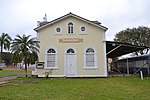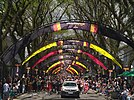This article needs additional citations for
verification. (March 2023) |
Santa Cruz do Sul | |
|---|---|
| Municipality of Santa Cruz do Sul | |
 Location in Rio Grande do Sul | |
| Coordinates: 29°43′04″S 52°25′33″W / 29.71778°S 52.42583°W | |
| Country | |
| Region | South |
| State | |
| Founded | 31 March 1877 |
| Government | |
| • Mayor | Telmo José Kirst ( PP) |
| Area | |
| • Total | 733.5 km2 (283.2 sq mi) |
| Elevation | 122 m (400 ft) |
| Population (2020)
[2] | |
| • Total | 131,365 |
| • Density | 180/km2 (460/sq mi) |
| Time zone | UTC-3 ( UTC-3) |
| HDI (2010) | 0.773 – high [3] |
| Website |
santacruz |
Santa Cruz do Sul ( ⓘ) is a city in central Rio Grande do Sul, Brazil. The city has an estimate 131,000 inhabitants as of 2020 and sits about 150 km (93 miles) from the capital city of the state, Porto Alegre. The city enjoys a high standard of living and gross income per capita is 2.5 times greater than that of the state of Rio Grande do Sul as a whole.
History
Santa Cruz do Sul was founded on March 31, 1877 by German immigrants, most of whom came from Hunsrück. Even today, the so-called Riograndenser Hunsrückisch is spoken actively in the area around the city. In 1924, a Protestant church was built according to the plans of two German architects. It is one of the largest Protestant Lutheran churches in Rio Grande do Sul and the largest neo-Romanesque church in Latin America. The Protestant church, renovated in 1999 with an organ from 1887 of the German company Ibach from Barmen.[ citation needed]
Demographics
The population of Santa Cruz do Sul has steadily increased, with help from immigration to Brazil during its early history – in 1849 there were 12 inhabitants, ten years later the city population had reached 2723 people, and in 1878 there were ten thousand inhabitants. [4] Most of the early immigrants were farmers and craftsmen.
Agriculture
The area around Santa Cruz do Sul is mainly agricultural, and produces large quantities of tobacco and soy beans for animal fodder. Most of the tobacco produced in the area is exported as a raw material for cigarette manufacturing plants all over the world. Soy bean processing plants sell several million tons of animal fodder annually, for domestic use and for export. [4]
Oktoberfest
Each year, the citizens of Santa Cruz do Sul and visitors from the region celebrate Oktoberfest. The city has a large population of German-Brazilians. Thousands turn out each year for the celebration. The Oktoberfest in Santa Cruz do Sul is the third largest in the world, leaving behind only the Oktoberfest in Munich in Germany and Oktoberfest Blumenau of the state of Santa Cartarina in Brazil as well.
Tourism
The Cathedral of São João Batista is one of the main tourist draws in the city. The adjacent block in front of the Cathedral, Getúlio Vargas Square, is adorned with fountains and trees. São João Batista Cathedral is one of the largest cathedrals in all of Brazil. The main edifice was built between 1928 and 1932 and the two 82-meter (269 ft) tall towers were added later.
Sports
The Autódromo Internacional de Santa Cruz do Sul is a motorsport racetrack opened in 2005. It hosts rounds of the Stock Car Pro Series and Copa Truck.
The two main football clubs are Esporte Clube Avenida and Futebol Clube Santa Cruz, which play in the Campeonato Gaúcho Série A2.
Transportation
The city is served by Luiz Beck da Silva Airport.
Awards
The Prefeitura Municipal de Santa Cruz do Sul won a 2004 Energy Globe Award for the João-de-Barro Bom-Plac House Project. [5]
Notable people
- Ana Hickmann, Brazilian model
- Lucas Kohl, Brazilian racing driver
- Irton Marx, journalist and politician
- Henrique Mecking, Brazilian chess Grandmaster
Notes
References
- ^ "Santa Cruz do Sul" (in Portuguese). Brazilian Institute of Geography and Statistics. Retrieved 21 Jan 2017.
- ^ IBGE 2020
-
^
"Archived copy" (PDF).
United Nations Development Programme (UNDP). Archived from
the original (PDF) on July 8, 2014. Retrieved August 1, 2013.
{{ cite web}}: CS1 maint: archived copy as title ( link) - ^ a b MONTALI, Lilia (1979). Universidade de São Paulo (ed.). Do núcleo colonial ao capitalismo monopolista: produção de fumo em Santa Cruz do Sul (Thesis) (in Portuguese).
- ^ "World Energy Globe Award (Earth)". Energy Globe. Retrieved 7 March 2017.
External links
-
 Media related to
Santa Cruz do Sul at Wikimedia Commons
Media related to
Santa Cruz do Sul at Wikimedia Commons -
 Santa Cruz do Sul travel guide from Wikivoyage
Santa Cruz do Sul travel guide from Wikivoyage - (in Portuguese) Santa Cruz do Sul City Hall website
- (in Portuguese) Gazeta do Sul - News from Santa Cruz do Sul
- Estacionamento Rotativo de Santa Cruz do Sul - Rapidinho
- Santa Cruz Oktoberfest site
- A Communitarian University - Universidade de Santa Cruz do Sul









